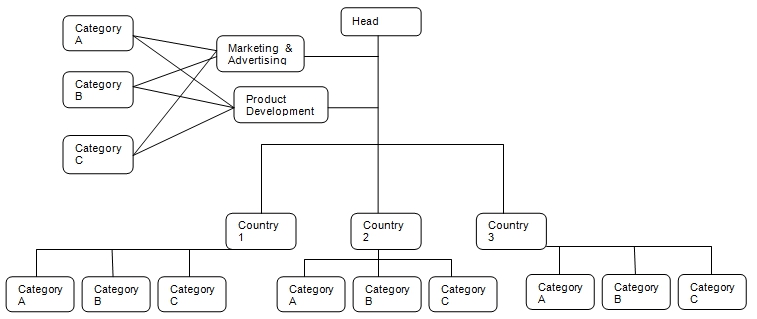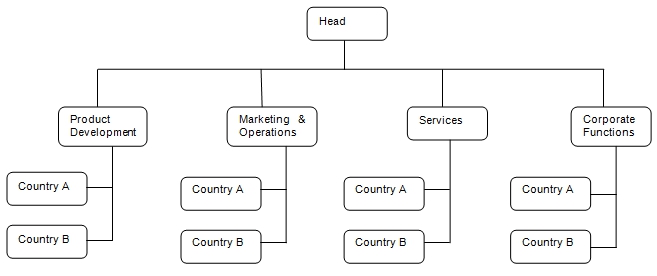Every organization has a need to formally coordinate the pattern of interaction between the organizational members. Thus organizational structure can be defined as the process of allocating tasks, coordinating between organizational members, and formalizing the ‘who reports to whom’ concept. Strategy is the long term goal and the objectives of the company which helps in allocation of resources, and corporate positioning.
Many organizational studies have established a link between organizational strategy and structure (Chandler, 1962; Miles & Snow, 1978; Potter, 1980; Mintzberg, 1994). This paper assumes this connection to be true, tries to develop two viable structures for a given organization. The organization we intend to study is Procter and Gamble (P&G).
To provide an overview about the company, P&G, established in 1837, are the providers of branded fast moving consumer goods (FMCG) and services. The main aim of the company is to provide innovative product to the consumer.
The corporate strategy of P&G is to “delight the consumer with sustainable innovations that improve the environmental profile of our products” and “improve the environmental profile of P&G’s own operations” (P&G, 2008).
Innovation and operational excellence being the main potent of the corporate strategy, the company aims to strive for continues and fast innovation which helps them to sustain in a highly competitive market.
Given this strategy of the company, we will try to demonstrate two viable strategies for the company. Here we will recommend two structures with discussion on basic form/design, considerations for centralization and show why this is a fit with the organization.
The first structure that we recommend for P&G is a category matrix structure (figure 1). A matrix structure is a structural design that arranges specialist functionalities or departments into one or more teams, which are led by project leaders. In a category matrix structure, we recommend that P&G use a category matrix structure.
This structure is based into groups of categories which are led by category managers who directly report to the country heads. As P&G’s operations are widely dispersed into different countries, it is important to have a country based operations.
The product development must be handled at one place to ensure uniformity of product offering at all geographic locations. The product development department is formed in a matrix structure to ensure productivity and innovation in each segment. Here the stress is on innovation wherein the nature of centralization lessens. This is to ensure a complete environment for innovation.
The product development Head reports to the company head. The categories are managed by a category manger who report to the product development head. The other important part P&G is marketing of the consumer products. This will be done through a marketing and promotion team which is again arranged in the same way as the R&D team.
This is to ensure that the message that goes out to the whole expanse of the company is one. All the countries where P&G operates should get the same message. This is ensured through the marketing and promotion team, which is again arranged in a matrix structure. The product development and Marketing team operate in close coordination.
The third important segment for P&G is the country operations. Since P&G has its operations, spread are many countries, it is important to have country based operations to increase its operational efficiency. Here only the category based sales departments are present who ensure efficient distribution of the products to the distributors.
The regional offices are headed by the Country Head who directly reports to the company head. This matrix form of structure arrangement minimizes hierarchy of command, and ensures that the marketing and the product development team work in close coordination to deliver what the customer actually need and want.
It also decreases formalization in the product development and marketing team as the strategies are drawn together. This process also increases the company’s sensitivity to the changing market demands and structure. This increases specialization of the categories. This helps to organize a flatter organization and ensures a more participative management.

The second structure that we recommend is a functional structure. Here the segregation is in the main functions of the company. Now it is important to understand which the broad functional necessities of P&G are. First is product development as innovation in the product is the main goal of the company. Second are global operations which have to be efficient.
Third, is the corporate functions like finance and accounts, HR, etc. and the fourth is the services section of the company which it has to provide to its customers. This structure increases the centralization of control, as the whole operations are less than one manager but also increases the specialization of the departments. This increases the span of control as the managers.
The structures in the functional departments are divided into geographic divisions. The functional departments work independently and concentrate in their own functionalities. This will increase the specialization of the department and hence its efficiency. The span of control is high for department heads as they have many managers reporting to them.
The degree of centralization is high as all the geographic operations are controlled from the main office. But with regional offices working closely with the head offices also ensure in providing insight into the local markets for developing product development and operational strategies. The importance of this structure lies in its degree of control with the head office and specialization.
As P&G is a big company with operations spread across the global and with their present aim to expand further, it is important to keep in mind that the corporate control over all the geographic units is important. This structure provides increased centralizations. The degree of formalization is high too. Further, this structure helps the MNC to be more ‘glocal’ applying its global goals in a local market.
Further, this structure helps the company to increase its efficiency and practice the old concept of division of labor to its optimum. With two separate departments of product development and marketing, the company can concentrate solely into the two functions. This increases specialization.
Further, due to its department orientation it reduces the vertical differentiation in the structure which reduces the layer of hierarchies as compared to a bureaucratic structure. Further, this structure increases the special differentiation.
This implies that the company can practice the same level of operations in multiple locations. The hierarchical levels are same. This structure increases formalization as the departments are segregated on the line of functionalities. So this structure is workable for a company which I s of a big size and operation as P&G.

Reference
Chandler, A. D. (1962). Startegy and Structure: Chapters in the History of the Industrial Enterprise. Cambridge, Mass.: MIT Press.
Miles, R. E., & Snow, C. C. (1978). Organizational Strategy, Structure and Process. New York: MacGraw Hill.
Mintzberg, H. (1994). Rise and Fall of Strategic Planning. New York: Free Press.
P&G. (2008). Sustainability Startegies and Goals for 2012.
Potter, M. E. (1980). Competitive Strategy:Techniques for Analyzing Industries and Competitors. New York: Free Press.